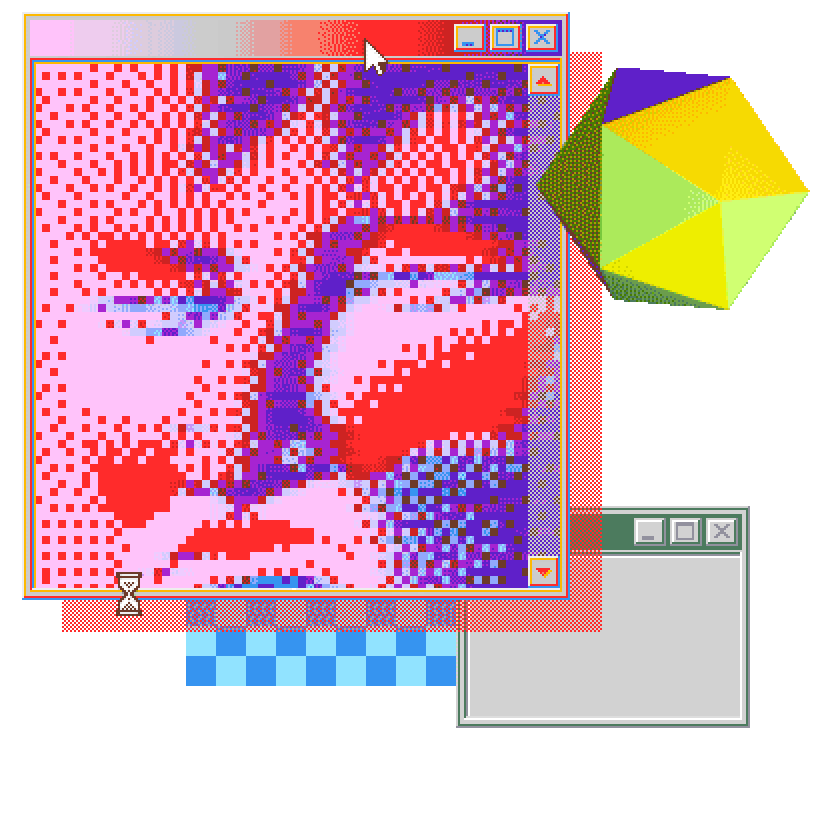TzAR: Pixel Art Profiles #10 – Víctor Arce, Green Ginger, Kristen Roos
Kyle Flemmer profiles three pixel artists with program windows included in their contributions to the forthcoming Tezos Art Review (TzAR): Pixel Art Anthology.
The aesthetics of the program interface have played an important role in forming the overall identity of digital art. Not only do the tools and capabilities of creative software like Adobe Photoshop, Microsoft Paint, Aseprite, and so on determine what is possible for digital art, but the look and feel of the program window itself has proven to be a potent influence as well. In terms of physical art, including the program window is akin to treating the frame as part of the painting. It is perhaps unsurprising that so many artists incorporate program windows into their art, given the sheer number of hours they spend looking at them while engaged in their creative practice, but its frequency should push us to ask why this is so.
A program window in a work of art raises questions about how the art is made and then presented. It returns the viewer’s awareness to the art as digitally constructed, composed, not by hand in the traditional sense, but by way of an elaborate technological apparatus. The program window draws a clear line between analog and digital modalities, foregrounding and celebrating this difference. TzAR: Pixel Art Review would not be complete without at least a few program interfaces to honor this prominent theme in digital art.
“Pixel Art Profiles #10 I am presenting three such works, each featuring a different approach to including program windows directly into the art. Whether it’s the tools of the design software, the desktop of a familiar OS, or the standard program window used as an explicit framing device, the user interface can itself be a tool for creative expression.”
Víctor Arce
internet_boredom.GIF by Víctor Arce, minted January 14, 2025
Artist statement: “To me, pixel art, and especially GIF art, are among the most interesting forms of expression that still thrive on modern screens. Even though we have moved beyond the medium's limitations, artists around the world continue to be drawn to tiny squares and limited color palettes. There’s something magical about it that goes beyond nostalgia.”
Green Ginger
90s Diaries by Green Ginger, minted March 27, 2024
Artist statement: “Our pixel art style consist of a variety of themes that includes isometric, scenery, minimalism, and abstract. This diversity allows us to express our different ideas given the fact that we’re working as two people. Partnership allows us to combine our different perspectives and strengths, producing a wide range of artistic expressions. We also often combine these themes to produce a more unique style. Our work blends nostalgia, inspiration from others, and our own creative vision to produce something uniquely ours. “90s Diaries,” for examples, uses a Windows XP theme to evoke memories to people who relate to that era. We’re also inspired from other artists across the internet. We use these exercises to broaden our pixel art techniques.”
Kristen Roos
SuperPaint by Kristen Roos, minted April 1, 2024
Artist statement: “Constraint is a major feature of the software that I use in creating my work, and this really defines the overall aesthetic of the work that appears in this book. My work is tied to the squareness of the pixel, and the gridded square space of the screen, and can be looked at as a kind of homage to the pixel. My work also traces the origins of digital paint software, and the various labs that invented the tools that allow for hand manipulation, painting and drawing on screens with pixels that we take for granted today. My work traces the roots of these tools and software, starting with the university, military and corporate labs of the 1950’s and 1960’s, that housed large mainframe computers. Since the tools that came out of these labs were not originally created for artistic purposes, I’m interested in how artistic practices were introduced into these labs, and how this affected the dawn of the personal computer and the first graphic user interfaces and screens. I’m also interested in how the screen became an interactive and creative space through the personal computer’s entry into the home. This history is inherently tied to the work that I create with hardware and software that was developed for a home market of personal computers between the late 1970’s - 1990’s. The way that I interact with a screen today, and how I currently create work using screens and pixels, makes references to various points in this history.”
TzAR: Pixel Art Anthology will be published by The Blasted Tree Publishing Co. in August 2025. Stay tuned for more Pixel Art Profiles in the coming weeks as we prepare the book for publication!




